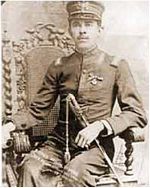La Brigada de Sinaloa notes
The federal forces in Mazatlán held out until 9 August 1914 when they evacuated by sea and the next day Colonel Angel Flores occupied the port. The federal notes must have quickly disappeared and were ultimately declared null and void by Carranza in a 23 October decree. In accordance with an authorization from the General en Jefe Alvaro Obregón on 19 August[text needed], the Constitutionalist army produced a series of notes, under the title ‘Pagaduria Gral. de la Brigada de Sinaloa’, with the date 21 August and signatures of Ramón Fuentes Iturbe as General Jefe de la Brigada, Manuel Roncal Gómez Llanos as Secretario de Estado Mayor A., and M. C. y Castro as Pagador General.
|
In 1912 he fought against the Orozquistas in Chihuaha and then received permission to study engineering in the United States. After the decena trágica he returned to the country and joined Alvaro Obregón in Nogales, Sonora, and led the forces in Sinaloa. On 30 August 1913 he seized Topolobampo. On 16 September Obregón appointed him head of military operations in the state. On 4 October he took Sinaloa de Leyva and on 28 October Carranza appointed him General de Brigada. He took Mazatlán on 9 August 1914. At the Convention in Aguascalientes he supported Carranza who appointed him head of the 3ª División del Noroeste, which controlled operations in Sinaloa, southern Sonora, Baja California and Tepic, when this region was abandoned by General Juan Dozal. Iturbe had to fight against Felipe Riveros and defeated him in La Paz, Baja California, on 8 December 1914. He then went to the help of General Juan Carrasco against Rafael Buelna in Tepic. From there he went north to prepare the offensive against José María Maytorena. He occupied El Fuerte and then defeated Macario Gaxiola at Bacamari; on 29 August he handed over command of the 3ª División del Noroeste to Manuel M. Diéguez and then received the appointment of head of military operations in Jalisco and Colima. In 1917 he was elected governor of Sinaloa and took office on 26 July, despite Carranza’s request that he stand down. He remained governor until September 1920. Then he served as Director of Cooperative Development in the Secretaría de Economía. He took part in the Escobarista rebellion of 1929, and as a consequence had to leave the country. Amnestied by the government, he returned on 27 July 1933. He served as a deputy in the XXXVII Federal Legislature (1937-1940) and from 1941 to September 1942 he was minister in Japan. He died in Mexico City on 27 October 1970. |
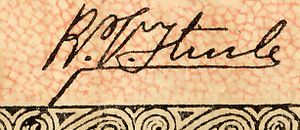 |
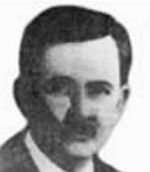
Manuel Roncal Gómez Llanos, as a Mayor, represented General Juan Carrasco at the Soberana Convención Revolucionaria in Aguascalientes. In 1920 he was elected Presidente Municipal of Mexicali, Baja California, as a candidate for the Partido Liberal Independiente. |
 |
| M. C. y Castro |  |
These Brigada de Sinaloa notes were printed by a local firm, the Imprenta Moderna, in six denominations.
25 centavos
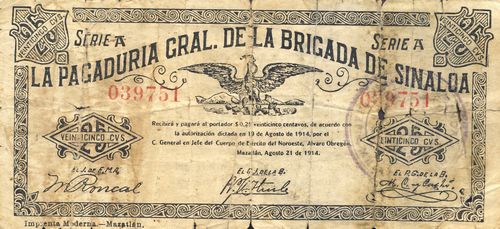
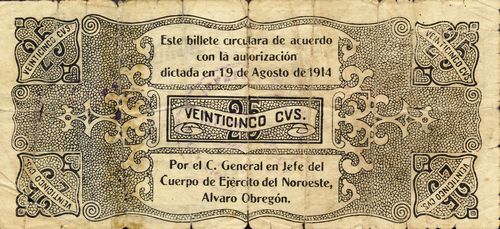
| Series | from | to | total number |
total value |
|
| A | includes numbers 078310 to 37891CNBanxico #12020 |
50 centavos
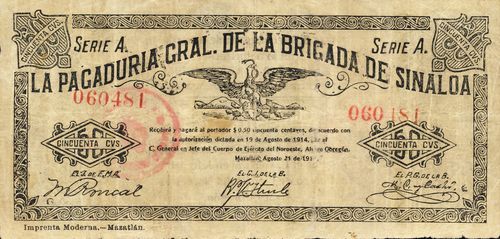
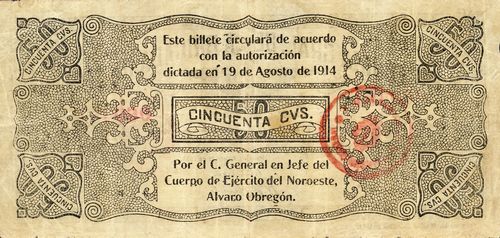
| Series | from | to | total number |
total value |
|
| A | includes numbers 042134CNBanxico #6202 to 059207 |
One peso
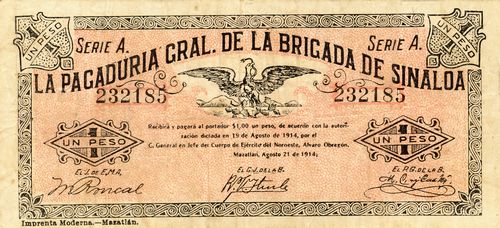
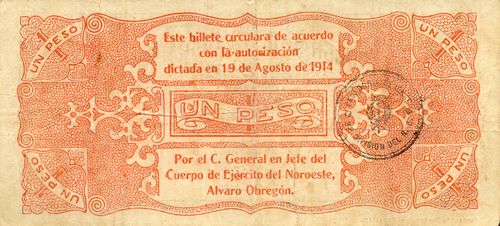
| Series | from | to | total number |
total value |
||
| $1 | A | includes numbers 62532 to 389225CNBanxico #6211 | ||||
| B | includes numbers 005875 to 135465 | |||||
| C | includes numbers 110775 to 193463 |
Five pesos
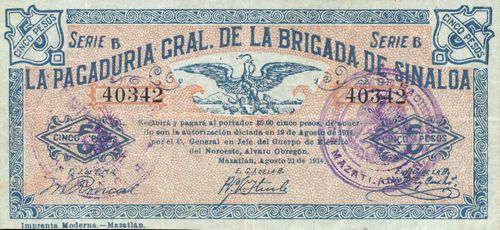
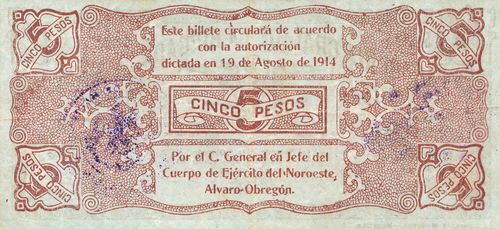
| Series | from | to | total number |
total value |
|
| A | includes numbers 23431CNBanxico #6222 to 32335CNBanxico #6221 | ||||
| B | includes numbers 007138 to 49462CNBanxico #6217 | ||||
| C | includes numbers 002554CNBanxico #6215 to 059845CNBanxico #6219 |
Ten pesos
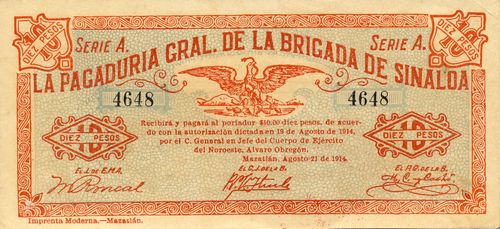
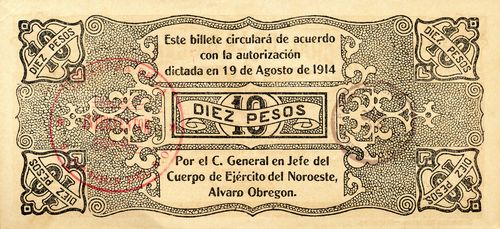
| Series | from | to | total number |
total value |
|
| A | includes numbers 1232CNBanxico #6223 to 22033CNBanxico #6225 | ||||
| B | includes numbers 006413 to 51384 | ||||
| C | includes numbers 017618CNBanxico #12025 to 059823 |
Twenty pesos
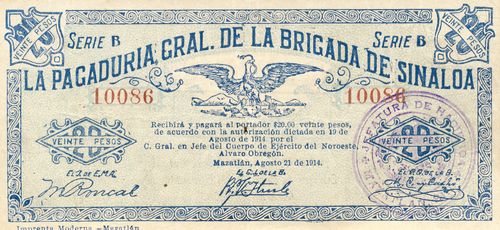
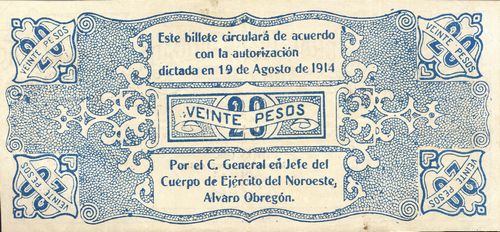
| Series | from | to | total number |
total value |
|
| A | includes numbers 1424 to 9982 | ||||
| B | includes numbers 0847 to 11688 |
Fifty pesos
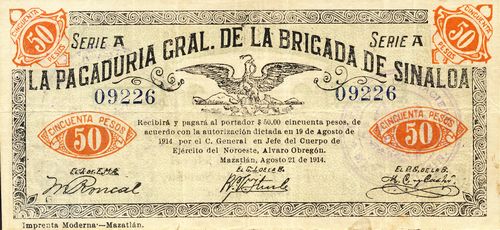
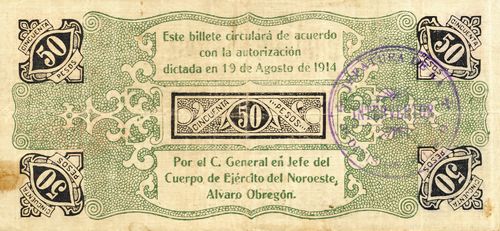
| Series | from | to | total number |
total value |
|
| A | includes numbers 02983CNBanxico #6233 to 09622 | ||||
| B |
These notes are known with the stamp of the Jefatura de Hacienda of Mazatlán on the face and either the Interventor of the Jefatura de la 3a División del N. O. or the Pagador de la 3a División del N. O. or both on the reverse.
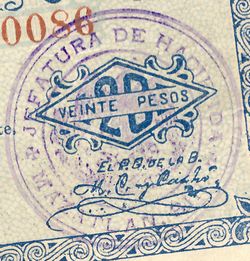
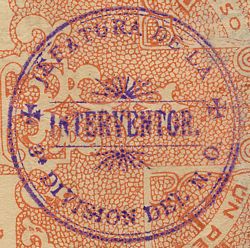
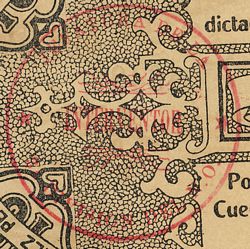
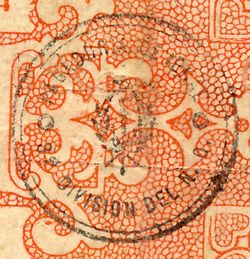
In February 1915 General de Brigada Juan Carrasco learnt that Carranza was sending ammunitions and a million pesos in paper money on the steamer Pacífico from Salina Cruz to Mazatlán. On 10 February he wrote to Carranza from his headquarters in Escuinapa that he intended to appropriate these and distribute the money – $500,000 to redeem the brigade issue (bonos emitidos por la brigada), $250,000 to General Flores for his troops and $250,000 for his own troops. He had taken this decision because of the problems with the brigade issue, which businesses and the general public were refusing to accept, and would make sure that the notes of the neediest classes were changed first, leaving the rich businessmen and individuals to the lastAIF, . Presumably, Carrasco is referring to these Brigada de Sinaloa notes.
Use in other states
Baja California
On 1 January 1915 the Presidente Municipal interino of Todos Santos, Baja California, asked La Paz whether the Brigada de Sinaloa notes were of forced circulation and was told that they were, as long as the Jefatura Política did not specify otherwiseABCS, Gobernación, vol. 647 2.2, exp. 46. On 8 July the Comandante Militar declared them, along with the Gobierno Provisional notes, as of forced circulation, so their use must have been widespread. Their validity was confirmed in later pronouncements on 2 August and 5 October.
Sonora
These notes were listed as of forced circulation by Manuel M. Diéguez on 14 October 1915. On 19 December Alvaro Obregón, in Guaymas, Sonora, dictated that while the Secretaría de Hacienda was establishing offices for exchange (oficinas canjeadoras correspondientes) and until new order, the Brigada de Sinaloa notes were among the issues in forced circulation. The governor of Sinaloa, Manuel Rodríguez Gutiérrez, published this disposition on the following day.
Chihuahua
When Luis Herrera took Parral in Chihuahua in November 1915 he included the Brigada de Sinaloa notes amongst the issues he declared to be of forced circulationAMPar, Gobierno, Jefatura Política y Presidencia Municipal, Correspondencia, caja 71, exp 2.
Withdrawal
In a circular núm. 10, dated 25 February 1915, Carranza’s Secretaría de Hacienda at Veracruz said that they had tolerated these notes whilst necessary but that now the Tesorería General de la Nación would exchange any on presentation. However, they continued to circulate for over a year.
In February 1916 a circular[text needed] explained that the Brigada notes were of forced circulation and anyone refusing to accept them would be severely punished. On 28 April 1916, as part of his scheme to unify the currency, Carranza listed twenty different issues made by Constitutionalist commanders that the Tesorería General de la Nación, the Jefaturas de Hacienda and the Administraciones Principales del Timbre would receive on deposit before 30 June to be exchanged in a manner to be decided at a later date. After 1 July these issue would be null and void and anyone who tried to circulate them would be punished. Among the issues listed were these Brigada de Sinaloa notes.
On 8 May the Comandante Militar at Mazatlán, C. C. Solis, stated that it was no longer possible to put up with the many complaints regarding those who refuse to accept notes of compulsory circulation, amongst which are “Brigadas” (Brigada de Sinaloa plus also Obregón’s and Diéguez’ issues) that by decree of the governor and jefe of the 3ª División del Noroeste, such merchants, persons and others who refuse to accept these notes would pay the penalty with their lives, irrespective of nationalitySD papers, 1910-1929, 812.515/112.
On 11 May the Secretaría de Hacienda y Crédito Público, in circular núm. 85, declared that in spite of Carranza’s decree withdrawing this issue, because of the lack of Gobierno Provisional and Ejército Constitucionalista notes the Brigada de Sinaloa notes had continued to circulate in the west of the country and depositing them would gravely prejudice the poorer classes who held most of these notes, so Carranza had authorized the Jefatura de Hacienda, Administraciones Principales del Timbre and Aduanas in Sinaloa and Tepic, to change notes presented in quantities up to fifty pesos, for Veracruz or Ejército Constitucionalista notes at a rate of one for two. This was confirmed in a telegram from the Jefe de Hacienda in Mazatlán. The amount accepted, but only in the case of the poorer classes, was increased to $100 on 17 May. These measures explain the notes with the overprint ‘Withdrawn from circulation (Retirado de la Circulacion)’ and stamp of the Recaudación de Rentas del Distrito de Mazatlán.
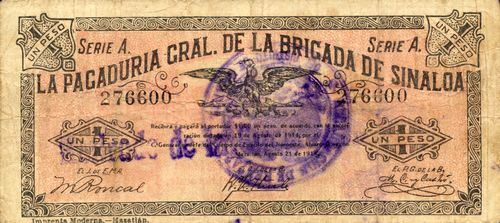
A week later, on 15 May, Solis repeated his threat, and said the Brigada notes should circulate at the exchange rate that had already been set. This, according to the governor, Angel Flores, was two Brigada for one Gobierno Provisional peso Periódico Oficial, Sinaloa, Tomo VII, Núm. 53, 16 May 1916. The next day the Comandante Militar in Culiacán, José Aguilar, in setting rates for the infalsificables, said that the rate for the Brigada de Sinaloa notes was eight pesos for one peso infalsificable. Even though the Brigada notes were to be withdrawn on 30 June, there was no need for alarm as the Administración Principal del Timbre had orders to exchange them for Gobierno Provisional de México and Ejército Constitucionalista notes. However, on the same day the Secretaría de Hacienda y Crédito Público told the Jefe de Hacienda in Hermosillo and the Administrador de la Aduana Maritima in Guaymas, Sonora, that Carranza, amplifying his circular núm. 85, authorised them to change the Brigada de Sinaloa notes for Gobierno Provisional and Ejército Constitucionalista notes for just the poorer classes and for amounts up to $100, at a rate of two for oneEl Constitucionalista, Tomo III, Núm. 169, 25 May 1 916.
On 18 May the Periódico Oficial reported as a late piece of news that Aguilar had declared that the Brigada de Sinaloa notes as well as the vales issued by Obregón and Diéguez were withdrawn from circulation (though they were still able to be exchanged)Periódico Oficial, Sinaloa, Tomo VII, Núm. 54, 18 May 1916. They were also accepted in payment of state and municipal taxes.
Finally, on 24 July 1916 Carranza decreed that from 1 August they would exchange the notes listed in the decree of 28 April that had been deposited in the offices of Hacienda with infalsificables at a rate of 10 to 1.

